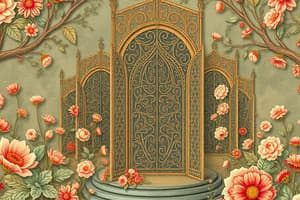Podcast
Questions and Answers
Art is defined as the ability to create meaningful new ideas and interpretations.
Art is defined as the ability to create meaningful new ideas and interpretations.
True (A)
Imagination plays no role in the creative process of art.
Imagination plays no role in the creative process of art.
False (B)
Expression is an automatic response in every individual's action and thought.
Expression is an automatic response in every individual's action and thought.
True (A)
The combination of creativity, imagination, and expression does not lead to the creation of impactful art.
The combination of creativity, imagination, and expression does not lead to the creation of impactful art.
Art is considered a universal concept that exists wherever humans have lived.
Art is considered a universal concept that exists wherever humans have lived.
Digital arts are not recognized as a valid category of modern creativity.
Digital arts are not recognized as a valid category of modern creativity.
Performing arts include only traditional forms of theater and music.
Performing arts include only traditional forms of theater and music.
Art can serve as a means for individuals to convey their individuality and way of life.
Art can serve as a means for individuals to convey their individuality and way of life.
Art is defined solely as a visual representation of beauty.
Art is defined solely as a visual representation of beauty.
According to Frank Lloyd Wright, art involves discovering and developing principles of nature into suitable forms.
According to Frank Lloyd Wright, art involves discovering and developing principles of nature into suitable forms.
Art has no significant impact on cultural and political movements.
Art has no significant impact on cultural and political movements.
Elbert Hubbard described art as a way rather than a tangible object.
Elbert Hubbard described art as a way rather than a tangible object.
The main purpose of art is to create something visually entertaining with no deeper meaning.
The main purpose of art is to create something visually entertaining with no deeper meaning.
Art is created by an artist and gains an independent existence upon creation.
Art is created by an artist and gains an independent existence upon creation.
Sculpture is a form of visual art only created by painting.
Sculpture is a form of visual art only created by painting.
Creativity in art is limited to traditional methods and does not include modern digital technologies.
Creativity in art is limited to traditional methods and does not include modern digital technologies.
Artists often think from a rational perspective similar to academics and policymakers.
Artists often think from a rational perspective similar to academics and policymakers.
Dance is classified under the performing arts category.
Dance is classified under the performing arts category.
Architecture involves only the decorative aspects of buildings.
Architecture involves only the decorative aspects of buildings.
Art contributes to the acceptance and tolerance of different cultures in modern societies.
Art contributes to the acceptance and tolerance of different cultures in modern societies.
Digital arts require the use of traditional tools such as brushes and canvases.
Digital arts require the use of traditional tools such as brushes and canvases.
The term 'film' refers to a series of moving images projected on a screen.
The term 'film' refers to a series of moving images projected on a screen.
Performance poetry is written solely for publication and not for live audiences.
Performance poetry is written solely for publication and not for live audiences.
Music is considered a cultural activity that organizes sound in time.
Music is considered a cultural activity that organizes sound in time.
Flashcards are hidden until you start studying
Study Notes
Creation of Art
- Art is created by an artist for an independent existence, ultimately controlled by the beholder.
- Involves the combination of medium elements like tones, words, and paints.
Categories/Classifications of Arts
-
Visual Arts (2D, 3D)
- Painting involves pigment application on surfaces.
- Sculpture encompasses carving, modeling, casting, and assembling materials into dimensional forms.
- Architecture combines art and science in designing structures for human use.
-
Performing Arts
- Music is an organized sound art form and cultural activity.
- Dance expresses ideas or emotions through rhythmic movement.
- Film consists of still images creating the illusion of motion on screen.
- Theater features live performances of real or imagined events before an audience.
- Literature focuses on the quality and content of written works.
- Performance Poetry is crafted for live performance, often encouraging improvisation.
-
Digital Arts
- Created with electronic devices, relying heavily on computers.
- Explores new ideas, interpretations, and originality beyond traditional methods.
- Tied closely to creativity, enabling the artist to merge thoughts and emotions into bold new works.
Assumptions of Art
- Art conveys individuality and encompasses universal themes.
- Plato viewed art as harmony with the world’s beauty; Ruskin saw it as the human spirit.
- Arthur Dow considered art a way of life and decision-making.
Generalizations About Art
- Defined as any creative human work with self-expression.
- Focuses on the quality of the creative process rather than just the final product.
- Art manifests beauty and represents mastery in execution.
- Viewed as a means to individualism and discovering natural beauty.
Importance of Art
- Artists create from passionate, visionary perspectives, influencing cultural and political movements.
- Art combats intolerance and racism, promoting societal acceptance.
- It reflects and enriches diverse cultures, empowering communities.
Creativity, Imagination, and Expression in Art
- Creativity transforms imaginative ideas into reality through perception and pattern recognition.
- It connects seemingly unrelated phenomena and generates solutions, showcasing the artist's unique worldview.
Studying That Suits You
Use AI to generate personalized quizzes and flashcards to suit your learning preferences.




